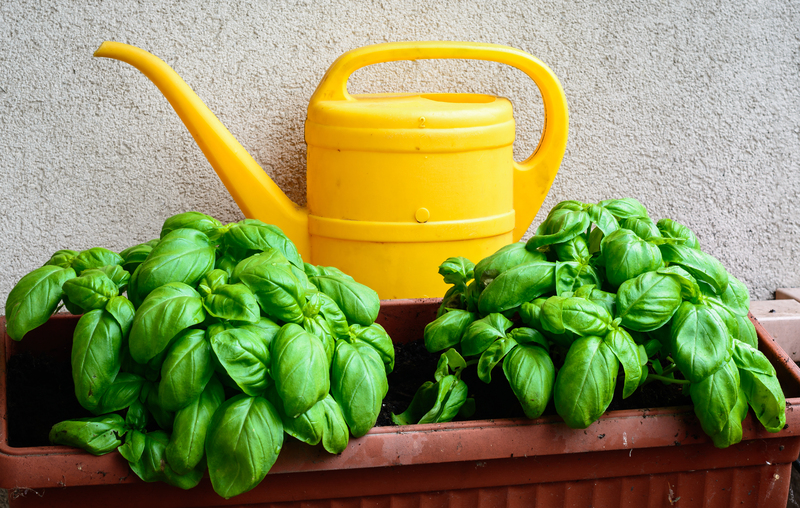Designing a Fun and Safe Garden for Children
Posted on 04/09/2025
Designing a Fun and Safe Garden for Children
Transforming your backyard into a haven for your kids can spark joy, creativity, and learning. But where do you start? In this comprehensive guide, we'll walk you through designing a fun and safe garden for children, blending playful inspiration with essential safety tips. Whether you have a spacious yard or a cozy balcony, let's explore practical ideas to create an outdoor space that nurtures curiosity and protects your loved ones.
Why Create a Child-Friendly Garden?
A child-oriented outdoor space offers more than just entertainment. Here are some compelling reasons to design a children's safe and fun garden:
- Physical Activity: Encourages movement, coordination, and healthy habits.
- Imagination and Learning: Stimulates creative play and curiosity about nature.
- Bonding Time: Allows families to connect outdoors.
- Environmental Awareness: Fosters respect for plants, insects, and animals.

Key Principles for Designing a Safe Garden for Kids
Balancing fun and safety is crucial when planning your garden. Consider these essential principles for a safe play garden for children:
1. Visibility and Supervision
Always prioritize clear lines of sight. Arrange play areas so you can easily watch youngsters from different angles. Trim tall shrubs, avoid dense plantings near play sets, and place seating for supervising adults.
2. Age-Appropriate Features
Design separate zones for toddlers, preschoolers, and older children. Tailoring activities and equipment ensures safety and engagement for all ages.
3. Safe Surfaces
The best playgrounds use impact-absorbing materials such as:
- Grass lawns
- Mulch or bark chippings
- Rubber matting or tiles
- Sand
Avoid hard surfaces like concrete, stone, or bricks in active play zones to reduce the risk of injuries.
4. Non-Toxic, Child-Safe Plants
Learn about plant toxicity and choose non-toxic, safe species. Avoid thorny or spiky plants, and pay attention to allergenic species. For a stunning and secure garden for kids, pick plants that are safe to touch, smell, and even taste!
5. Secure Boundaries and Gates
Install child-proof fencing and gates. Check for gaps or loose boards, and secure any entrances. Self-closing, self-latching gates add an extra layer of protection for young explorers.
6. Remove Hazards
- Keep tools and chemicals locked away.
- Cover ponds or water features with strong mesh or fencing.
- Watch for tripping hazards like garden hoses, uneven pavers, or exposed roots.
Child-Friendly Garden Features for Fun & Learning
A playful, kid-friendly garden design ignites imagination. Here are some ideas to inspire your outdoor transformation:
1. Play Spaces
- Sandpit: Ideal for hours of creative digging, building, and sensory play. Use rounded timber edges and cover at night to keep animals out.
- Playhouse or Den: Build a DIY wooden playhouse or a simple teepee from fabric and poles to provide secret hideouts for role play.
- Treehouse: For older children, a treehouse with sturdy railings and climbing routes can become a treasured retreat.
2. Activity Zones
- Swings and Slides: Install securely anchored swing sets or slides on soft surfaces. Regularly inspect for worn or rusted parts.
- Obstacle Courses: Lay out stepping stones, balance beams, or low tunnels--perfect for developing motor skills while burning off energy.
- Hopscotch and Chalk Art: Paint hopscotch squares or a chalk board wall for endless games and drawings.
3. Garden Adventures
- Bug Hotels: Build habitats from old wood, bamboo, and straw to attract insects and foster a love of wildlife.
- Butterfly or Bee Garden: Plant brightly colored flowers to invite pollinators. This teaches children about biodiversity and the food chain.
- Sunflower Maze: Grow towering sunflowers in rows or circles for a living maze to hide and run among.
4. Creative and Sensory Elements
- Water Play: Provide a shallow splash pad or water table. Always supervise water play to prevent accidents.
- Musical Features: Install wind chimes, drum panels, or outdoor xylophones made from bamboo or metal piping.
- Edible Gardens: Set up raised beds for veggies and herbs. Kids love planting seeds, watching them grow, and tasting the harvest!
Safe Plant Choices for a Kid-Friendly Garden
When designing a child-safe garden, avoid plants that are toxic, spiny, or irritating. Some popular safe options include:
- Sunflowers: Easy to grow and impressive in size.
- Sweet Peas: Fragrant and colorful, but avoid eating the seeds.
- Marigolds: Non-toxic and natural pest repellents.
- Strawberries: Easy edible crop for little hands.
- Lamb's Ear: Soft, tactile leaves invite gentle touch.
- Nasturtiums: Bright blooms are edible and visually appealing.
- Mint: Fragrant, fast-growing, and safe (but can be invasive--contain in a pot).
Avoid: Foxglove, lily-of-the-valley, oleander, yew, laburnum, datura, and any mushrooms unless you are certain of their identity.
Essential Safety Checklist for Kid-Friendly Garden Design
- Fence your garden with at least 1.2m (4ft) around children's areas.
- Inspect play equipment regularly for damage or loose fittings.
- Use non-slip paving in paths and patios.
- Keep chemicals, sharp tools, and lawnmowers in locked sheds.
- Cover open water sources or install vertical water walls for splash play instead of ponds.
- Teach children about safe and dangerous plants with visual signs or activity sheets.
- Remove tripping and choking hazards and keep play areas clutter-free.
- Stay current on first aid information and keep a kit accessible.
Remember, supervised play is the safest kind of play.
How to Foster Creativity and Learning in the Garden
The best child-friendly gardens are living classrooms. Here's how to nurture imagination, curiosity, and discovery:
- Let kids choose what to plant: Give children their own section or containers to grow favorite flowers, fruits, or vegetables.
- Make it sensory-rich: Use plants and features with interesting textures, scents, and sounds--think lavender, rosemary, ornamental grasses, and water features.
- Add discovery trails: Create meandering pathways lined with stepping stones, signs, or footprints leading to fun surprises.
- Incorporate art and crafts: Use the garden outdoors for painting, making leaf collages, or clay modeling with natural materials.
- Embrace wild corners: Set aside an area for wilder growth, bug hunting, or bird feeding.
Maintaining a Safe and Fun Child's Garden
Regular checks keep your garden oasis both safe and enjoyable.
- Inspect for broken toys, splintered wood, or sharp edges on equipment.
- Prune back overgrown plants where children play.
- Check for invasive weeds or unfamiliar fungi.
- Keep play surfaces clean and switch out materials if they become worn or moldy.
- Update garden features as children grow and their interests change.
Child-Friendly Garden Ideas for Small or Urban Spaces
No backyard? No problem! You can design a safe and fun garden for kids even within smaller footprints:
- Container gardens: Grow herbs, strawberries, and flowers on balconies or patios.
- Vertical gardens: Use wall planters or trellises for climbing beans, sweet peas, and nasturtiums.
- Mini sandbox: Try a repurposed storage container or tire sandpit.
- Movable play mats: Use soft foam tiles outdoors for hopscotch or safe rolling.
- Chalk walls or easels: Let kids draw outside, then wash down at the end of the day.
- Tabletop water play: Fill plastic tubs for supervised splashing.
With creativity and thoughtful design, even the coziest spot becomes a magical, safe haven.
Eco-Friendly Options for Children's Gardens
Instill environmental values by choosing sustainable materials and practices:
- Recycle and upcycle: Repurpose old pallets for planters or benches, use tires for planting or play.
- Collect rainwater: Set up barrels with childproof covers to water plants sustainably.
- Compost together: Teach about recycling food scraps and garden waste.
- Pick natural mulches: Avoid dyed or chemically treated mulches in play areas.
- Use solar lighting: Safely light trails and features with energy-saving solar garden lights.
Letting Children Lead: Involving Kids in Garden Design
Involving your child in planning and building their own safe and fun garden builds ownership and enthusiasm. Here's how:
- Host a garden "design day"--let kids sketch, draw, or build a model of their dream space.
- Let them personalize with painted pots, name signs, or decorated stepping stones.
- Encourage responsibility with jobs like watering, harvesting, or feeding wildlife.
These activities nurture creativity, responsibility, and a deep connection to nature.

FAQs: Designing a Fun and Safe Garden for Youngsters
What are the most important safety features for a child's garden?
The most critical safety elements include secure fencing, non-toxic plants, impact-absorbing play surfaces, and supervised water play. Regular safety checks and age-appropriate zones further reduce risks.
How can I make my garden educational as well as playful?
Install activity zones like bug hotels, integrate edible planting beds, and label plants with fun facts. Let children participate in planting and caring for the garden to maximize learning.
Which plants are both safe and easy for children to grow?
Good options include sunflowers, nasturtiums, marigolds, strawberries, snap peas, mint (in pots), and lamb's ear. These are non-toxic, easy to handle, and forgiving for beginners.
Is it possible to have a safe children's garden in a small space?
Absolutely! Balcony gardens, raised beds, vertical planters, and container veggies enable families to create magical, safe play and growing zones, even in the smallest courtyards or patios.
Conclusion: Cultivating Childhood Memories Outdoors
Designing a fun and safe garden for children is an investment in joy, education, and well-being. By blending creative play features with robust safety measures, you'll nurture a lifelong love for nature and the outdoors. With every seed sown and adventure explored, your garden will become a cherished part of your family's story.
Ready to get started? Gather your little gardeners, put on your gloves, and let the outdoor adventures begin!
For even more inspiration and resources, explore local gardening clubs, online communities, or child-friendly landscape designers. Every child deserves a safe and magical space to grow.

